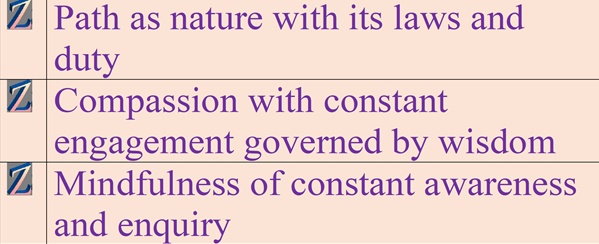14) Faith - the 16th step

This chapter is definitely not for Buddhadasa purists – if any of the Companion is. Fundamentally the Companion is a pragmatic addition based on various issues that have arisen during Zandtaomed’s learning and work. Is such a pragmatic addition the approach of a purist?
This chapter has come from Viveka-Zandtao. Viveka is an approach that Buddhadasa supported, for Zandtao out of this solitude grew quest into the unknown and then faith. From Viveka-Zandtao there came a two-step understanding of the path, the step of faith being new:-
 Building the complete vihara to bring in the light of consciousness. Building the complete vihara to bring in the light of consciousness.
 Dedicating to our faith in the path so that we can bring in the light of consciousness. Dedicating to our faith in the path so that we can bring in the light of consciousness.
As I am discussing MwB these two steps are changed, but mean the same:-
 Building the complete vihara to connect to the Dhamma. Building the complete vihara to connect to the Dhamma.
 Dedicating to our faith in the Dhamma so we can connect to it. Dedicating to our faith in the Dhamma so we can connect to it.
Let me discuss MwB in terms of these two steps of pathtivism. I suggest that the four tetrads are concerned with building the vihara, the vihara being the abiding that enables us to connect to the Dhamma; vihara is a word Buddhadasa used in Void Mind. For this abiding (vihara) we improve our bodies - kaya, energy – vedana, heart-mind – citta, and we integrate the three in the 4th tetrad of completion ready to connect to the Dhamma.
Before starting Viveka-Zandtao my focus was on vihara only. We work to improve the vihara, my practice was MwB to do this. But I realised that MwB was concerned with perfecting the vihara, that perfection is something I can work towards but it will never be for me. I work on the vihara but I need an extra boost – the magnetic force of faith.
Let us consider the 4th tetrad. Steps 13, 14, and 15 are developing the 3 characteristics of Buddhism – anicca, quenching dukkha and anatta. According to Busddhadasa in MwB, Step 16 is giving back to nature what we appropriated as ego – kilesa and upadana. Through Viveka-Zandtao I recognised that addiction, obsession, attachment and clinging are misdirected aspects of faith, the magnetism attracting to egos as attachments and clinging in daily life rather than connecting with Dhamma. So as we build up the vihara especially in steps 10 and 12 where we let go of attachment and clinging, we are also releasing faith’s magnetic force. As we optimise the vihara (as best we can perfecting it in the meditation), then we throw back what we have taken and use the magnetism to connect to the Dhamma – bringing in the light of consciousness. For me this is the 16th step - having built our vihara during MwB released magnetism of faith can bring in "new" light of consciousness.
In terms of Buddhadasa’s teachings this change is not so important. Through MwB and his other teaching there is completion of the vihara that connects to the Dhamma. Zandtaomed wishes to focus on faith as the final step because of the  . Look at what is happening in our faithless society, it is directionless – no path. Through conspiracy and other mechanisms our minds attach to self-destructive egos. There is no wisdom there, only a magnetic force seeking some attraction. Ideologies such as Marxism achieve almost religious status, even idolising popstars or sportspeople has become unbalanced because of this directionless magnetic force. Because of the . Look at what is happening in our faithless society, it is directionless – no path. Through conspiracy and other mechanisms our minds attach to self-destructive egos. There is no wisdom there, only a magnetic force seeking some attraction. Ideologies such as Marxism achieve almost religious status, even idolising popstars or sportspeople has become unbalanced because of this directionless magnetic force. Because of the  caused by the lack of path such misplaced force creates social imbalance. This is not helped by conditioning that works against the true path like a disembodied ego defending itself. caused by the lack of path such misplaced force creates social imbalance. This is not helped by conditioning that works against the true path like a disembodied ego defending itself.
Even when there is religious faith it is ditthupadana and silabattupadana. Faith is not concerned with beliefs, rites or rituals. Beliefs are ideas, at best teachings that with understanding can guide us, but without understanding beliefs are just ideas that fill the contents of consciousness. If rites and rituals are not conscious actions on the path, if they are simply enacted as a required routine, then they are mindless, wasted consciousness – not sampajanna. Faith has a magnetic function that attracts us to our paths, our buddha-nature, these paths have direction given by nature and fit in with nature’s purpose – dhammajati. Without such direction faith can be attracted to all and sundry including addiction, obsession, attachment and clinging. Society needs to recognise this vacuum and work towards filling it by educating about path not religious ideologies, by examining the conditioning ensuring conditioning does not work against path by at least providing the faith tripod of #NatureCompassionDecency. Unfortunately society is so defiled it is not ready to consider faith and the vacuum that exists, and the result is continued defilement as faith has no direction to take society back to nature.
In Viveka-Zandtao I suggested this faith tripod as a means of trying to protect against cults, cults are the most obvious example of where faith has been misdirected. It was my proposal that this tripod form the essence of education and upbringing so that no matter what life confronted us with as adults falling back on these three pillars would give us the strength and understanding necessary to cope. Unfortunately given the defiled state of society and its conditioning this tripod is not likely to be delivered in education institutions because the tripod will go against the inherent greed within our social system. However parents can instill the tripod as part of their upbringing, and unlike some ways in which parents try to fashion their children this tripod is natural.
With MwB this tripod is developed, first as dhammajati with its 4 laws of nature, in MwB sila or decency starts with the 5 precepts but is developed as we see through our understanding (panna) that no society can function without it being basically decent. And compassion is a vihara developed throughout MwB because we are ending and then quenching dukkha so that there is freedom from suffering for all. As we practice MwB we develop the 4 Dhamma comrades that provide the real strengths for coping with life.
As a pathtivist I must point out a danger with faith and compassion, this is when this vihara of compassion acts with the force of faith unwisely. Immediately we feel compassion we want to help, it is also natural to give so our faith pulls us into giving, and this giving can happen unwisely. Unwise giving can be exploited by the defiled so we need wisdom with our giving. Faith can pull us towards ideologies such as socialism because socialism and Marxism put forward proposals that will supposedly end suffering for all. Isn’t that compassion? However in real life socialist practice can ask for actions which are not compassionate as a matter of party discipline – or even as the case with Bolshevism calling for violence when peace could not be ensured to follow. Panna (wisdom) and sampajanna (wise action) are two comrades that can help our faith and compassion not to act mistakenly. Compassion is a vihara, it is not the path – no matter how close. The path has the attributes of all the viharas so if we have faith in the path as opposed to an individual vihara then such mistakes cannot be made. We have faith in the path so that we can use our compassion wisely, our wisdom avoids ditthupadana – clinging to ideologies such as socialism even though our compassion must attract us to such ideals.
In chapter 12 I spoke of the coolness of atammayata, this is also connected to faith even though faith as a force is not cool by nature. In the state of atammayata we are “unconcoctable”, we do not attach to any conditions. These conditions can arise through attachment to kaya, vedana, sanna and sankara – 4 of the 5 khandhas. Attached vinnana is the clinging or upadana that creates the conditions. The 4 khandhas have unattached functions to perform so we do not cling to these functions – they are performed and let go hopefully.
In our meditation we can work on ending such upadana. As part of the first tetrad we end upadana to kaya, this can be an active step as part of the calmness at the end of step 4. As part of the second tetrad we release attachment to vedana and as a final part of the calmness and coolness of step 8 we can end upadana to vedana. Sanna and sankara are khandhas associated with citta so in step 12 we can end any upadana to these mental faculties whilst also ensuring we are not clinging to the 4 upadanas of kama, ditthi, silabatta and attavada. This brings us to the final step. We have ended upadana to these 4 khandhas, we have released the attached vinnana, and we have also released the magnetic force (tanha and upadana) of our faith. At this point to the best of our abilities with MwB we are not concoctable, we are in a state of atammayata hopefully. In this free state, we can use the magnetic force of our faith to bring in “new” light of consciousness - connect to the Dhamma. We have done our best to create the sunnata-vihara so that we can touch sunnata:-
“The Buddha’s mind dwelt in the ‘sunnata abiding’ (sunnata-vihara), that is, he dwelt with his mind touching sunnata, free from any disturbance, knowing all things as they really were – as void of ‘self’” [Void Mind p29].
This quote from "Void Mind" connects well with:-
 Dedicating to our faith in the Dhamma so we can connect to it. Dedicating to our faith in the Dhamma so we can connect to it.
We can take our faith and dedication further with abiding - 24/7 abiding.
/Companion Contents/Previous
|





